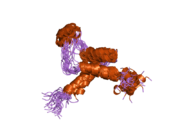Biology:TEAD4
 Generic protein structure example |
Transcriptional enhancer factor TEF-3 is a protein that in humans is encoded by the TEAD4 gene.[1][2][3]
Function
This gene product is a member of the transcriptional enhancer factor (TEF) family of transcription factors, which contain the TEA/ATTS DNA-binding domain.[4] Members of the family in mammals are TEAD1, TEAD2, TEAD3, TEAD4. TEAD4 is preferentially expressed in the skeletal muscle, and binds to the M-CAT regulatory element found in promoters of muscle-specific genes to direct their gene expression. Alternatively spliced transcripts encoding distinct isoforms, some of which are translated through the use of a non-AUG (UUG) initiation codon, have been described for this gene.[3] Gene ablation experiments in mice (i.e. knockout mice) showed that TEAD4 is essential for the formation of blastocysts during preimplantation embryo development.[5][6] Although it was originally hypothesized to be essential for specification of trophectoderm lineage, it was later shown that functional trophectoderm can be produced leading to formation of blastocysts under in vitro conditions that suppress oxidative stress.[7] Transcriptional coregulators, such as WWTR1 (TAZ) bind to members in this transcription factor family.
References
- ↑ "Localization of human transcription factor TEF-4 and TEF-5 (TEAD2, TEAD3) genes to chromosomes 19q13.3 and 6p21.2 using fluorescence in situ hybridization and radiation hybrid analysis". Genomics 55 (1): 127–9. January 1999. doi:10.1006/geno.1998.5628. PMID 9889009.
- ↑ "Cloning of human RTEF-1, a transcriptional enhancer factor-1-related gene preferentially expressed in skeletal muscle: evidence for an ancient multigene family". Genomics 37 (1): 68–76. October 1996. doi:10.1006/geno.1996.0522. PMID 8921372.
- ↑ 3.0 3.1 "Entrez Gene: TEAD4 TEA domain family member 4". https://www.ncbi.nlm.nih.gov/sites/entrez?Db=gene&Cmd=ShowDetailView&TermToSearch=7004.
- ↑ "The TEA domain: a novel, highly conserved DNA-binding motif". Cell 66 (1): 11–2. July 1991. doi:10.1016/0092-8674(91)90132-I. PMID 2070413.
- ↑ "Transcription factor TEAD4 specifies the trophectoderm lineage at the beginning of mammalian development". Development 134 (21): 3827–36. November 2007. doi:10.1242/dev.010223. PMID 17913785.
- ↑ "Tead4 is required for specification of trophectoderm in pre-implantation mouse embryos". Mechanisms of Development 125 (3–4): 270–83. 2008. doi:10.1016/j.mod.2007.11.002. PMID 18083014.
- ↑ "TEAD4 establishes the energy homeostasis essential for blastocoel formation". Development 140 (17): 3680–90. September 2013. doi:10.1242/dev.093799. PMID 23903192.
Further reading
- "Oligo-capping: a simple method to replace the cap structure of eukaryotic mRNAs with oligoribonucleotides". Gene 138 (1–2): 171–4. January 1994. doi:10.1016/0378-1119(94)90802-8. PMID 8125298.
- "Identification of a murine TEF-1-related gene expressed after mitogenic stimulation of quiescent fibroblasts and during myogenic differentiation". The Journal of Biological Chemistry 271 (23): 13786–95. June 1996. doi:10.1074/jbc.271.23.13786. PMID 8662936.
- "A novel family of developmentally regulated mammalian transcription factors containing the TEA/ATTS DNA binding domain". The Journal of Biological Chemistry 271 (36): 21775–85. September 1996. doi:10.1074/jbc.271.36.21775. PMID 8702974.
- "Construction and characterization of a full length-enriched and a 5'-end-enriched cDNA library". Gene 200 (1–2): 149–56. October 1997. doi:10.1016/S0378-1119(97)00411-3. PMID 9373149.
- "TONDU (TDU), a novel human protein related to the product of vestigial (vg) gene of Drosophila melanogaster interacts with vertebrate TEF factors and substitutes for Vg function in wing formation". Development 126 (21): 4807–16. November 1999. doi:10.1242/dev.126.21.4807. PMID 10518497.
- "TEAD/TEF transcription factors utilize the activation domain of YAP65, a Src/Yes-associated protein localized in the cytoplasm". Genes & Development 15 (10): 1229–41. May 2001. doi:10.1101/gad.888601. PMID 11358867.
- "Transcription enhancer factor-1-related factor-transgenic mice develop cardiac conduction defects associated with altered connexin phosphorylation". Circulation 110 (19): 2980–7. November 2004. doi:10.1161/01.CIR.0000146902.84099.26. PMID 15520314.
- "Towards a proteome-scale map of the human protein-protein interaction network". Nature 437 (7062): 1173–8. October 2005. doi:10.1038/nature04209. PMID 16189514. Bibcode: 2005Natur.437.1173R.
- "Identification of novel alternatively spliced isoforms of RTEF-1 within human ocular vascular endothelial cells and murine retina". Investigative Ophthalmology & Visual Science 48 (8): 3775–82. August 2007. doi:10.1167/iovs.06-1172. PMID 17652751.
External links
- TEAD4+protein,+human at the US National Library of Medicine Medical Subject Headings (MeSH)
 |


